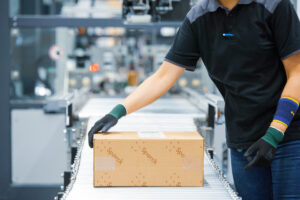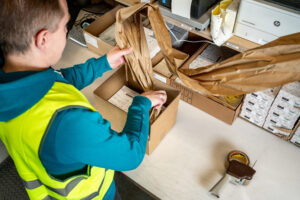How automated packaging systems help companies effectively balance higher-order throughput with labour utilization and cost savings in today’s fast-paced fulfilment environment.

Automating the high-speed Warehouses
Growing e-commerce order volumes, labour constraints, final-mile challenges, and heightened delivery expectations are all putting unique pressures on the nation’s fulfilment operations. With many of these operations still reliant on manual processes, spreadsheets, and ageing technology systems, keeping up with the competition and meeting ever-changing customer demands are difficult at best.
A task that’s ripe for automation, parcel packaging is one link in the fulfilment chain that’s still handled by employees who receive the goods, select the shipping box, pack the goods, insert the void fill, label the parcel, and then send it to the shipping department. This critical-but-redundant task can easily be handled by automated equipment which, in turn, lets employees focus on more important activities inside the warehouse.
 “E-commerce businesses are facing a ‘perfect storm’ of increasing order volumes coupled with fast-diminishing labour availability, says Jo Bradley Jo Bradley <link: https://www.linkedin.com/in/jo-bradley-54a7ba11/>, Business Development Manager at Sparck Technologies. “Cost pressures too, along with mounting consumer concerns over excessive packaging and large voids around packed items, are leading to a significant rise in interest in automated packaging solutions”.
“E-commerce businesses are facing a ‘perfect storm’ of increasing order volumes coupled with fast-diminishing labour availability, says Jo Bradley Jo Bradley <link: https://www.linkedin.com/in/jo-bradley-54a7ba11/>, Business Development Manager at Sparck Technologies. “Cost pressures too, along with mounting consumer concerns over excessive packaging and large voids around packed items, are leading to a significant rise in interest in automated packaging solutions”.
The Race for Fast and Free
Accustomed to the promises of next-day delivery, today’s consumers expect their online orders to arrive quickly. With their next competitor just a single screen tap or mouse click away, companies can’t afford to disappoint buyers for whom “fast and free” matter more than anything else. Meeting these demands requires an omnichannel fulfilment strategy that allows consumers to research, shop, and return on their own terms.
“To keep up with these and other demands,” says Bradley, “companies are reimagining their fulfilment operations and placing a bigger focus on operational sustainability.” Consumers’ demands don’t end there. In fact, today’s buyers also want to know that the companies they’re buying from are operating sustainably, treating their employees well, and doing what they can to eliminate waste.
 The High Cost of Shipping “Air”
The High Cost of Shipping “Air”
Oversize boxes aren’t just an annoyance to consumers. Without adequate dunnage in the voids, goods can be damaged in transit, and boxes become more susceptible to crush damage. Oversize boxes create unbalanced loads, causing back problems for warehouse and delivery staff, even when the overall weight of the package is quite low. Oversize boxes also waste transport space and delivery vehicles invariably ‘max out’ on volume long before they reach weight limits. Shipping empty space simply doesn’t make sense – it’s wasteful both environmentally and financially.
Automated Packaging Helps Companies Do More with Less
 Today’s manufacturers, distributors, e-commerce companies, and retailers want lower packaging and shipping costs. Their customers expect fast, free and sustainable delivery and packaging. Automated packaging technology checks off all of these boxes while delivering a host of other benefits for the companies that use them.
Today’s manufacturers, distributors, e-commerce companies, and retailers want lower packaging and shipping costs. Their customers expect fast, free and sustainable delivery and packaging. Automated packaging technology checks off all of these boxes while delivering a host of other benefits for the companies that use them.
The typical manual packaging process handles a maximum of 30-40 boxes per hour. It’s a labour-intensive task that can be sped up by 10-15 times using one operator with an auto-boxing system like the CVP Impack <link: https://bit.ly/3q8hwVA>. A next-generation solution, the CVP Everest <link: https://bit.ly/3ifuAUJ> cuts even more time out of the process by supporting higher throughput levels while maintaining high levels of accuracy and productivity. The CVP packaging solutions are also scalable and able to eliminate multiple, standard box SKUs that have to be kept on hand (e.g., to accommodate seasonal labour swings).
With productivity as an important key performance indicator (KPI) for today’s fulfilment centres, automated packaging systems help companies offset labour constraints and help them allocate workers to important tasks like picking orders. With the CVP handling the bulk of the work, employees can also be assigned to packaging overflow during peak or holiday seasons.
“Most e-commerce companies are having a difficult time finding and retaining labour right now,” says Will Carder <link: https://www.linkedin.com/in/will-carder-9038686a/>, Sales Engineer at Sparck Technologies. Labour force consistency adds to the problem, as does the need to have enough people available to handle full production capacity. Once they put in an automated packaging system, those worries immediately fade and operations can scale up as the machine takes on the box selection and entire packing process.
 Sparck’s automated packaging machines decrease the need for excess labour and can save companies the cost of up to 20 labourers per shift—labour that can be upskilled to more important activities. The machines also help ensure optimal labour, material, shipping and transportation savings, especially during peak seasons.
Sparck’s automated packaging machines decrease the need for excess labour and can save companies the cost of up to 20 labourers per shift—labour that can be upskilled to more important activities. The machines also help ensure optimal labour, material, shipping and transportation savings, especially during peak seasons.
Multiply that activity across thousands of parcels per day, and the value of automated fit-to-size packaging becomes extremely clear. Even better, transportation costs drop significantly and CO2 emissions are reduced when the right sized box is used to transport goods to their destinations.
Creating the Perfect Package, Every Time
Utilized by a wide variety of industries, including e-commerce, retail, third-party logistics (3PL), wholesale, and manufacturing, automated packaging can improve the customer experience while solving many of today’s shipper’s biggest pain points. Because they use multiple different widths of fan-fold corrugated cardboard, the CVP Impack <link: https://bit.ly/3q8hwVA>. and CVP Everest <link: https://bit.ly/3ifuAUJ> allow companies to size boxes to the products they’re shipping, and not the other way around.
 The CVP Automated Packaging Solutions effortlessly create, fill, fold and label each parcel in one seamless process – reducing package volumes by up to 50%, cutting cardboard usage by 30% and eliminating the need for void fill.
The CVP Automated Packaging Solutions effortlessly create, fill, fold and label each parcel in one seamless process – reducing package volumes by up to 50%, cutting cardboard usage by 30% and eliminating the need for void fill.
Interestingly, multiple corrugate feeders are becoming more popular with ecommerce businesses as different widths of cardboard can be selected automatically by the machine to minimize off-cuts – and branded board is also an option.
The Next Generation of Automated Packaging
 With a maximum speed of 1,100 boxes per hour, the CVP Everest is the fastest automated packaging solution on the market for fit-to-size boxes. Like the CVP Impack, the machine auto-boxes single- and multi-item orders of both hard and soft goods without the need for additional equipment or operators, thus saving companies valuable time and money. Built with advanced software, both solutions integrate with any warehouse management system (WMS) to create a streamlined fulfilment process within the four walls of any warehouse or DC operation.
With a maximum speed of 1,100 boxes per hour, the CVP Everest is the fastest automated packaging solution on the market for fit-to-size boxes. Like the CVP Impack, the machine auto-boxes single- and multi-item orders of both hard and soft goods without the need for additional equipment or operators, thus saving companies valuable time and money. Built with advanced software, both solutions integrate with any warehouse management system (WMS) to create a streamlined fulfilment process within the four walls of any warehouse or DC operation.
 The automated packaging systems are also ergonomically-friendly for operators and eliminate many of the “pains” of standing at a packaging station, selecting and packing orders for an entire shift. As companies seek out new ways to improve efficiencies, save money, and meet their customers’ ever-changing demands, more are turning to automation for help. Using automated packaging solutions, these companies can generate the smallest parcel needed, optimize all steps of parcel fulfilment, and reduce their labour, shipping, and material costs.
The automated packaging systems are also ergonomically-friendly for operators and eliminate many of the “pains” of standing at a packaging station, selecting and packing orders for an entire shift. As companies seek out new ways to improve efficiencies, save money, and meet their customers’ ever-changing demands, more are turning to automation for help. Using automated packaging solutions, these companies can generate the smallest parcel needed, optimize all steps of parcel fulfilment, and reduce their labour, shipping, and material costs.
 Learn more at sparcktechnologies.com or contact Jo Bradley, Business Development manager at Sparck Technologies. Mail to j.bradley@sparcktechnologies.com or call +44 7715 084108
Learn more at sparcktechnologies.com or contact Jo Bradley, Business Development manager at Sparck Technologies. Mail to j.bradley@sparcktechnologies.com or call +44 7715 084108



